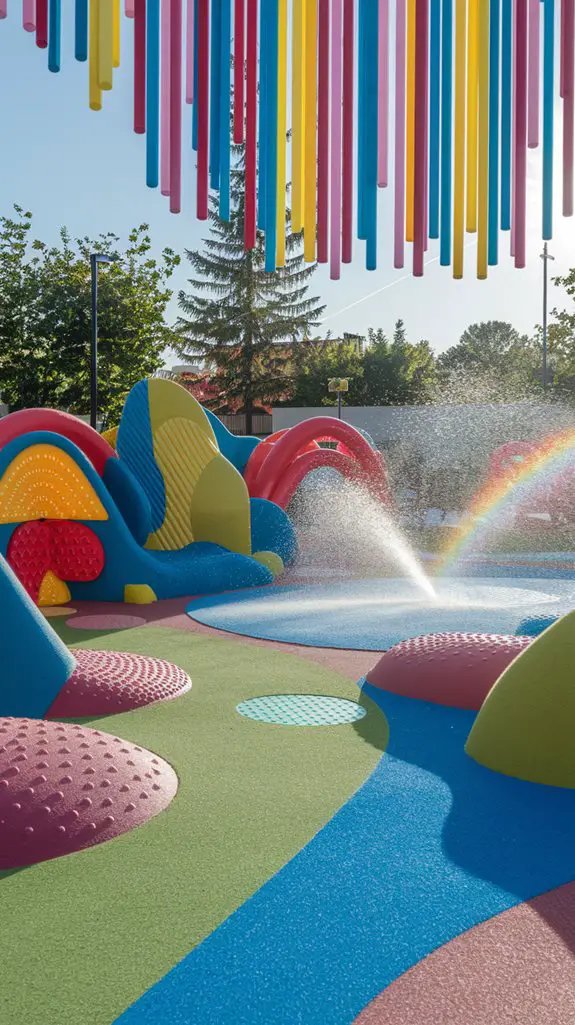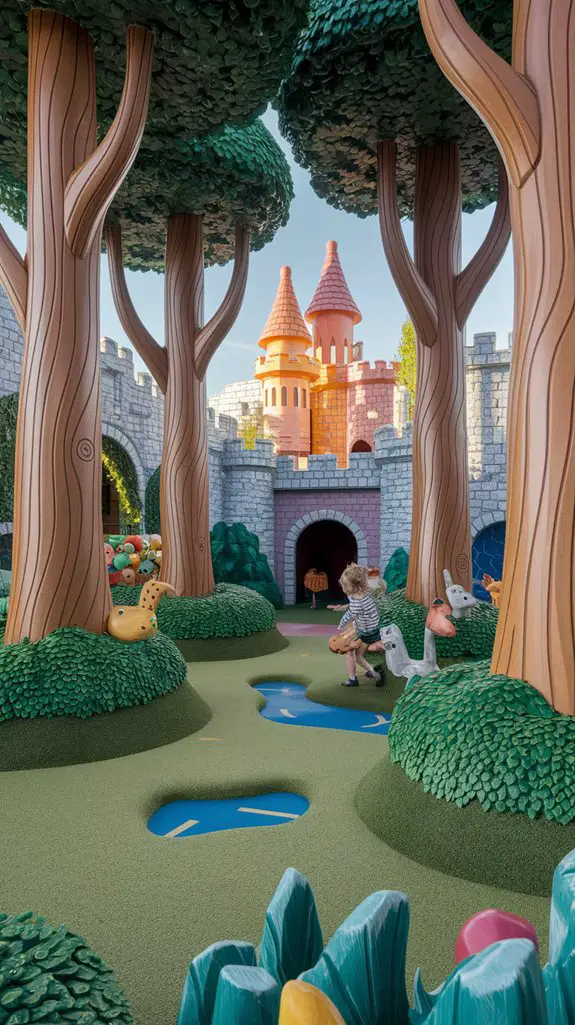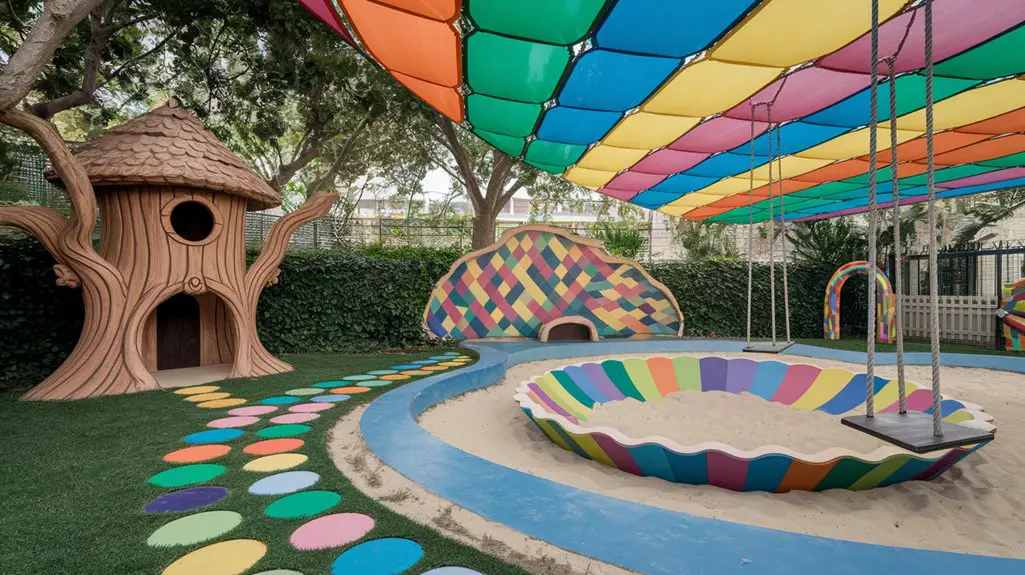When Jenny transformed her yard’s corner with a fallen tree stump, some colorful fabric, and river rocks, her 4-year-old’s outdoor play time doubled while screen time decreased noticeably. You don’t need an expensive playground setup to create a space that supports your child’s development. The right play area design can enhance creativity, build motor skills, and foster independent exploration. These five design approaches will help you create a unique play environment your children won’t want to leave.
Incorporating Natural Elements for a Whimsical Outdoor Escape
When designing outdoor play spaces, incorporating natural elements transforms ordinary areas into enchanting environments where children can explore, imagine, and connect with nature.
You’ll create richer sensory experiences by installing log balance beams, stepping stones, and sand pits that encourage motor skill development while sparking creativity.
Consider adding a small vegetable garden where children can plant seeds and observe growth cycles, fostering scientific thinking and responsibility.
Natural materials like tree stumps, boulders, and weather-resistant wooden structures provide variable climbing challenges that adapt to different developmental stages.
Research shows that nature-based play spaces greatly improve children’s focus, problem-solving abilities, and emotional regulation. Additionally, creative DIY ideas can enhance these environments, offering unique play experiences that captivate children’s imaginations.
Creating Multi-Sensory Play Zones That Spark Imagination

Beyond the natural world, multi-sensory play zones offer children immersive experiences that engage all their developing senses. You’ll create richer developmental opportunities when you thoughtfully design zones that incorporate touch, sound, smell, and sight.
| Sense | Play Elements That Stimulate |
|---|---|
| Touch | Textured panels, sand tables, water features |
| Sound | Musical instruments, echo tubes, wind chimes |
| Sight | Colorful panels, light tables, kaleidoscopes |
| Smell | Aromatic plants, scented play dough, herb gardens |
Consider creating dedicated stations for each sense with clear shifts between zones. Research shows children with sensory-rich environments develop stronger cognitive connections and improved spatial awareness. Incorporate elements that change with interaction, like kinetic sculptures or motion-activated sounds, to reward curiosity and build cause-effect understanding. These dynamic spaces don’t require expensive equipment—many sensory elements can be crafted from recycled materials. Additionally, backyard obstacle courses can be a fun way to enhance physical play and sensory exploration in outdoor environments.
Custom Themed Playgrounds That Tell a Story

Themed playgrounds transform ordinary play spaces into immersive storytelling environments where children become active participants in narratives that unfold around them.
When designing these spaces, you’ll want to select themes that resonate with your target age group while offering educational value.
Consider incorporating local history, natural ecosystems, or beloved literary works that children can explore physically. Research shows that narrative-based play enhances language development, social skills, and abstract thinking.
For preschoolers, focus on recognizable elements like animals or vehicles; elementary-aged children benefit from more complex scenarios that encourage role-playing.
Ensure the theme extends beyond decorative elements into the actual play structures. A pirate ship shouldn’t just look like a ship—it should enable climbing, steering, lookout positions, and hidden treasures that advance the storyline through physical interaction. Additionally, including exciting backyard games can further engage children and enhance their imaginative play experience.
Space-Saving Designs for Compact Backyards
Despite limited square footage, compact backyards can host engaging play areas that maximize children’s developmental benefits. Vertical designs utilize wall space for climbing walls, hanging activity panels, or fold-down art stations that can be tucked away when not in use.
Consider multi-functional equipment like storage benches that double as balance beams or sandbox covers that transform into drawing surfaces. Sensory walls mounted to fences stimulate cognitive development without consuming precious ground space.
For toddlers, create defined zones using colorful outdoor rugs rather than permanent structures. Preschoolers benefit from modular components you can reconfigure as skills develop. Research shows that even small spaces with varied textures and challenges enhance gross motor skills equally well as larger playgrounds. Additionally, incorporating themed backyard play areas can spark creativity and engagement, providing a unique environment tailored to children’s interests.
Incorporate hideaway elements—collapsible tents or hanging canopies—that provide vital imaginative play opportunities without permanent spatial commitment.
Weather-Resistant Materials for Year-Round Adventure
When selecting materials for children’s play areas, durability against diverse weather conditions becomes paramount for maintaining safe, engaging environments throughout the seasons.
You’ll want materials that withstand both scorching summers and freezing winters while remaining developmentally appropriate for various age groups.
Research-backed weather-resistant options include:
- Composite decking – Offers splinter-free surfaces that resist warping, fading, and mold growth, ideal for 2-12 year olds who need stable surfaces for gross motor development.
- Powder-coated metal – Provides rust resistance for climbing structures that support vestibular development in 4-10 year olds.
- HDPE plastic – Maintains structural integrity through temperature fluctuations while offering appropriate tactile stimulation for sensory development across age ranges.
Additionally, incorporating backyard enclosures for pets can enhance the safety of play areas, ensuring that children can enjoy their space without the distraction or danger posed by roaming animals. These materials guarantee consistent play opportunities regardless of season, supporting continuous physical and cognitive development.
Conclusion
You’ve now discovered the blueprint for creating a magical play world where your child’s development flourishes naturally. Just as seedlings need diverse environments to grow strong, your little one thrives in spaces that challenge their senses and imagination. Whether you’re working with a sprawling yard or a cozy corner, these design principles adapt to your needs while standing up to whatever weather comes your way. Your child’s perfect playground awaits your creative touch.




